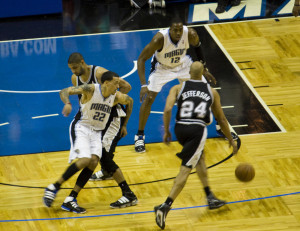Attacking the Hip of the On-Ball Screen Defender

In an On-Ball Screen situation, the offense must be well drilled in how to achieve their goal of creating a scoring opportunity. It is not uncommon in these situations for offensive players to lack the conviction and confidence to achieve a positive outcome for their efforts and good intentions. An on-ball screen can be a very effective tool in creating mismatches and forcing defenders into poor choices, but there are some non-negotiable tactics that need to be implemented to get the job done.
One of these non-negotiable tactics for the on-ball screen is attacking the hip of the screen defender. This is only one in a series of specific instruction points, but is one of the more poorly performed aspects.
Attacking the hip of the on-ball screen defender will result in a number of positive outcomes not always evident to players initially during its implementation. So coaches must be consistent and even handed in their directions insisting on the performance of the tactic and not be wavered by poor performance initially.
The first point for this tactic to be effective is to ensure the ball handler is in a low stance, ready to explode off the mark. The first two dribbles will be vital in setting the right tone to the on-ball screen action. The dribbler must be looking to move onto the screen defender’s high side hip (hip closest to halfway) and then curl their way into the keyway.
By attacking the hip of the screen defender, the dribbler places the player into a poor situation. If the defender is slow (which is usually the case as the screen defender is a Power Forward or Centre and their footwork is usually slower than the dribbler), then a defensive foul is likely. If the defender is quick then there are two scenarios that are at play. The first is it becomes a battle of wills between the dribbler and defender to see who will give up first. Most times the dribbler if they are in a good low and balanced dribbling position can still ride over the screener even if their original line is somewhat flared. If the dribbler finds themselves hesitating, then they will usually be pushed out of any effective outcome and the on-ball screen will break down.
Think about this though, when was the last time you saw an offensive foul called on a dribbler using an on-ball screen. It is rarity and one that often does not get called consistently, if it does indeed get called once at all.
The other option of the dribbler is to perform a quick crossover and split the offensive screener with their defender. This is often a good tactic after a few successful outcomes of on-ball screening, as the defender will start to anticipate movement trying to stop the on-ball screen strategy and start to slide prior to the dribbler reaching the correct position.
Ultimately, the dribbler wants to enter the keyway just below the strong side high post, as this will be the longest rotation within the keyway for help defence closeout and in turn provide good separation between the help defences match-up and the offensive player who will now be unguarded.
Attacking the hip of the on-ball screen defender not only helps with the primary outcome of the tactic, which is for the dribbler to move into a scoring position. But also starts to produce other options as teams attempt to limit the production generated from an effective and efficient on-ball screen strategy.







